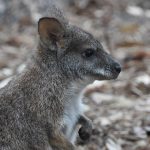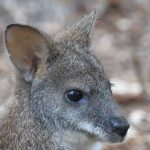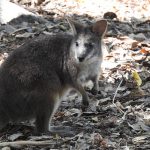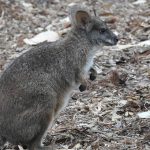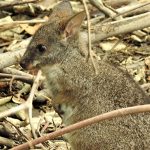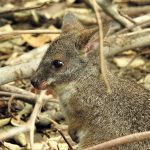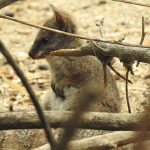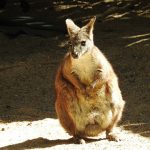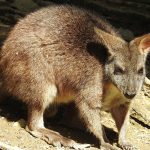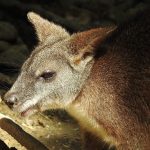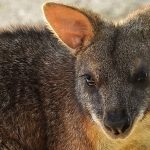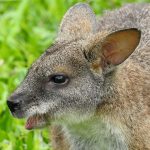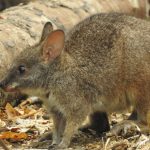PARMA WALLABY
The Parma Wallaby: A Tale of the Forest Shadows
In the cool, damp forests of eastern Australia, a small, secretive marsupial lives quietly amongst the tangled understory. The Parma wallaby is a little-known member of the kangaroo family, distinguished by its understated elegance and quiet resilience.
A Master of Camouflage
Imagine the Parma wallaby nestled among dense ferns and dew-soaked foliage. Its fur—shades of greyish-brown to reddish-brown—melds seamlessly with the forest floor, while that distinctive white cheek stripe glimmers softly when a shaft of moonlight finds it. Down its back, a subtle dark stripe traces from the nape to the shoulders—a natural brushstroke.
| Feature | Description |
|---|---|
| Size | 40–50 cm body length, tail even longer |
| Weight | 2–4 kg |
| Fur | Greyish/reddish-brown, pale underbelly |
| Markings | White cheek stripe, dark dorsal stripe |
| Tail | Long, used for balance |
Habitat: The Secret Gardens of Eastern Australia
Picture a landscape of moist, hilly forests. Tall eucalypts tower overhead, and below, mists linger in the mornings, beading along the leaves of shrubs and grasses. Here, in south-eastern Queensland and north-eastern New South Wales, the Parma wallaby finds its home where the undergrowth is thick, offering both shelter and a hidden larder of foliage.
- Habitat Requirements:
- Dense, moist forests
- Hilly or mountainous terrain
- Rich understory vegetation
Daily Life: Shadows, Silence, and Agility
Nocturnal by nature, Parma wallabies stir as dusk descends. They move with quiet purpose, each hop cushioned on the leaf litter, the muted sounds a clear adaptation to their secretive way of life. Agile and cautious, they prefer solitude or, at most, the company of a mate or small group—always ready to disappear into the shadows at the faintest disturbance.
- Shy and easily startled
- Exceptional jumpers, skilled at quick escapes
- Most active during the night, resting during daylight hours
Diet: The Art of Selective Browsing
If you pause amid the silence, you might hear the faint sound of a Parma wallaby nibbling on soft grass blades or tearing tender new leaves. With care, they select only the most nutritious parts of plants, foraging on:
- Grasses and herbs
- Young leaves
- Fleshy fruits
This selective feeding helps them maintain health in forests where food can be abundant yet patchy.
Life Cycle: From Tiny Joey to Forest Dweller
A remarkable story unfolds within the mother’s pouch. After a gestation of about 33–38 days, a vulnerable, bean-sized joey is born. It crawls, almost blindly, to the safety of the pouch, where warmth and milk await.
- Development Stages:
- Birth: Underdeveloped joey enters pouch
- Growth: Months spent safely nursing and maturing
- Independence: Weaning at around 8–9 months
The pouch is a marvel—a protective nursery travelling through the heart of the forest.
Hidden Wonders: Extraordinary Survival, Senses, and Stories
Once Thought Lost to Time
Almost like a tale spun from folklore, the Parma wallaby was believed extinct for nearly a century. First described in 1841, it seemed to vanish, only to be rediscovered in New South Wales in the 1960s, astonishing the scientific community and reminding us that the wild often keeps its best secrets close.
International Escapees
Even as their fate in Australia was uncertain, a small population of Parma wallabies survived in New Zealand zoos, descended from individuals introduced in the late 1800s. This unlikely safety net preserved genetic diversity until their wild cousins were found anew.
Expert in Invisibility
The Parma wallaby’s capacity to “freeze” in place serves as a masterful defence. Blending perfectly into shaded leaf litter and undergrowth, it avoids detection by both predators and people. If you find yourself treading softly in their habitat, the only clue to their presence may be the brief glint of a white cheek stripe as they hold perfectly still.
Sharpened Senses
Life on the forest floor has heightened the Parma wallaby’s senses. Their large, swivelling ears constantly sample the environment for sound, and their keen sense of smell not only warns of danger but also helps them find food and communicate subtle social cues.
Gentle Voices in the Undergrowth
Though mostly silent, Parma wallabies communicate with soft grunts and gentle clucking sounds—intimate notes exchanged between mothers and joeys or as warnings to neighbours, almost undetectable unless you are very close.
Digestive Ingenuity
With a diet often sparse in nutrients, Parma wallabies have developed an efficient digestive system, extracting maximum nourishment from the forest’s modest offerings and allowing them to survive where others might not.
Forest Custodians
As they browse, Parma wallabies gently shape the structure of the understorey, fostering diversity and creating microhabitats for other species. Their presence is key to sustaining the delicate health of Australia’s forests.
Conservation Status: The Challenge of Survival
The Parma wallaby’s soft steps grow fewer each decade. Classified as Vulnerable by the International Union for Conservation of Nature (IUCN), it faces:
- Habitat loss and fragmentation (deforestation and land clearing)
- Introduced predators (dogs, cats, foxes)
This decline is a gentle reminder of how finely balanced these hidden lives are within our forests.
Conservation: A Shared Responsibility
When we preserve forests and manage threats from invasive species, we help ensure the Parma wallaby’s story continues. Protecting their habitat means not only supporting one species, but also the rich diversity of life that shares these ancient woodlands.
Closing Thoughts
The Parma wallaby may be shy and seldom seen, but its quiet existence enriches the tapestry of Australian wildlife. Through careful stewardship and growing awareness, we can all play a part in ensuring that the soft footfalls of this gentle wallaby remain a part of our forests’ whispered stories.
Even in the deepest shadows of the forest, the Parma wallaby’s tale endures—a living legacy of resilience and the quiet power of nature, waiting to be discovered and protected.

